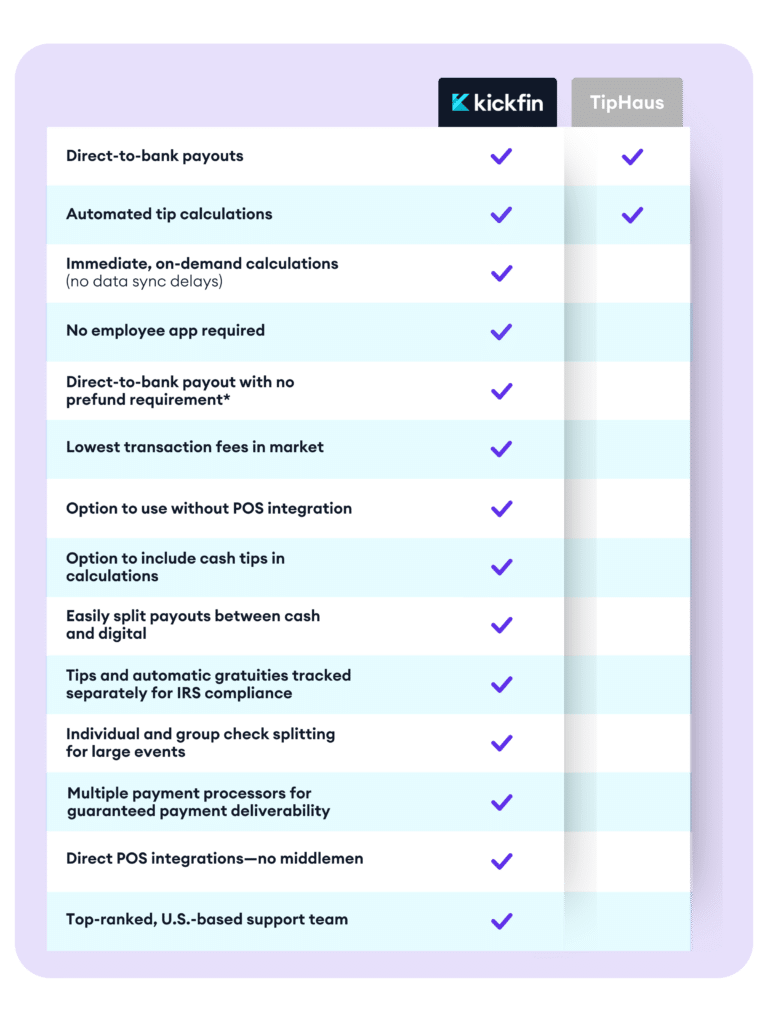Calculating tip pools can be hard. But calculating tip pools at 2 a.m. in the back office after pulling a 10-hour shift? Let’s just say that’s not anyone’s idea of a good time.
Restaurant managers have a lot on their plates, and for teams that still tip out in cash, you can add bank teller-slash-mathematician to their job description, too.
Tip pooling can be a great way to ensure everyone on your team gets rewarded for a job well done. But if it’s not done accurately, fairly, and legally, the consequences can be anything from accounting headaches to unhappy employees to serious lawsuits.
To ensure you get all of the benefits of tip pooling and without the risk: here are a few best practices and formulas that you can put to work.
Setting a tip sharing policy
Tip pooling and tip sharing are two ways restaurant owners can increase employee wages without increasing labor costs, and it can help foster a sense of teamwork among employees. It does, however, mean that your managers will need to do a bit of math before distributing tips at the end of a shift.
First things first, you need to choose a tip pooling or tip sharing system and stick with it. Here are some easy ways to split tips between employees — and how to calculate tips for each of them.
- Tip Pooling
If you want to collect all tips and redistribute them evenly, tip pooling is for you. This is a way to ensure that all servers, bussers, cooks, hosts, and dishwashers benefit from the tipping system. Everyone has a stake in the game to provide excellent service to guests. However, tip pooling is heavily regulated — so make sure you check out your state’s tip pooling laws before implementing this system.
To calculate each employee’s tips after a shift, you generally just need to divide the total tips by the number of eligible employees:
- 3 servers, a bartender, and a host are all eligible for tips
- Total tips = $1000
- $1000 tips / 5 employees = $200 each
In restaurants, shifts can often be unpredictable. One server may get cut way earlier than the other, so splitting evenly doesn’t always feel fair — and employees may not be willing to work under this system. To make things more equitable, some restaurants choose to split pooled tips a different way. If you’d like to follow the “hours worked” system, you can divide the tips by the total number of hours worked and tip each employee based on their hours worked. For example:
- 2 servers and 1 bartender are eligible for tips
- Server #1 and the bartender worked 8 hours each
- Server #2 worked 4 hours
- Total tips = $500
- Total hours worked = 20
- Each hour worked = $25 in tips
Now we’ll multiply each employee’s hours by 25 to find out how much they earned this shift:
- Server 1 = $200
- Server 2 = $100
- Bartender = $200
This system requires a little more thought (and in real life, the numbers won’t be quite as clean), but your servers and bartenders may find this more agreeable than an even split.
2. Tipping out
Most servers are familiar with “tipping out,” a system where they share a percentage of their tips with bartenders, hosts, and other support staff. In this scenario, the server keeps the majority of the tips they’ve personally earned, but other staff members are still rewarded for their contribution.
Usually tip out percentages are based on sales. You’ll need to set your own tip out policies, but here’s an example of how to calculate tip outs:
- Your servers tip out 5% of alcohol sales to bartenders and 2% of food sales to the host
- A server sold $500 in alcohol and $1000 in food
- The server received $300 in tips
- Bar tip out = $25
- Host tip out = $20
- The server would leave with $255 in their pocket
3. The Point System
While very similar to the “tip out” system we just described, the point system is another valid way to share tips among employees. You assign a point value to each role in the restaurant, and use those values to distribute tips. Here’s an example of how it works when there are 2 servers, a host, and a bartender working together:
- 2 servers = 35 points each
- Host = 10 points
- Bartender = 20 points
- Total tips = $1000
- Total points = 100
- $1000 in tips / 100 points = $10 per point
Now, you multiple each worker’s points by 10 to see their tips earned for the night:
- Server tips = $350 each
- Bartender tips = $200
- Host tips = $100
Go Cashless
No matter which system works best for you, we also recommend ditching cash tips. After doing all the tip calculations for the night, the last thing your managers want to do is sit and count cash.
Go digital with Kickfin instead. Our tip distribution platform allows you to quickly input employee tips and send money straight to your employees’ bank accounts. Your managers will save time, your employees will be happier, and you’ll save on labor costs. Request a demo to see Kickfin in action today.






